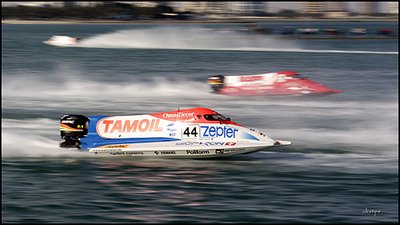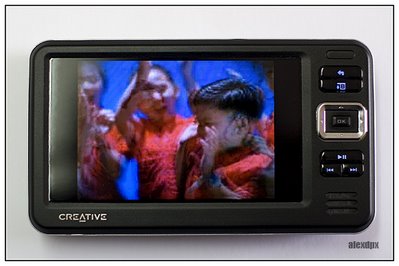 Swimmers in the 1500m freestyle event during Day 7 of the 15th Asian Games.
Swimmers in the 1500m freestyle event during Day 7 of the 15th Asian Games.
The topic here is competitive sports, not some model doing some sports action poses or some athlete posing for a photoshoot (such as Maria Sharapova's Canon advertisement photos). It's real sports action by athletes in actual competition. Here, you won't have control over lighting, background and subject. Most sporting events prohibits the use of flash so you'll have to shoot with available light. The sporting venue will be as it is. You cannot ask people to move away or remove some sporting paraphernalia just because they are distracting elements to your photos. You cannot interact with the athletes. In fact, you need some 'stealth' to avoid being noticed and cause distractions to them. Your control is basically limited to your skills and your photographic equipment.
Capturing sports action is relatively easy once you've grown accustomed to the basic techniques and have developed a strategy. Just like any type of photography, good planning helps a lot.
THE RIGHT PLACE AT THE RIGHT TIME

For this shot, I selected a spot where the boats turn because this is where they slow down and try to overtake each other.
You should have the venue well scouted for the best view angles available to you. It would definitely be an advantage if you've been to the venue before because you would know the best seats for your photographic purposes. If not, try to come early to have a good look at the place. Most sporting event tickets are general admission (non-reserved seats) so coming early allows you to choose where you want to sit.
The idea is to get as close as possible to the action. For example, you can't get a good shot of the player shooting a basket if you're on the other side of the court. Choosing your seat well gives you a better chance of being at the right place at the right time.
Of course you'll have better chances if you have a press pass. A press pass allows you to move around along with other official photographers and get closer where no spectator would be allowed to. However, you'll have that tendency to shoot from the same spot as the other official photographers. When you do, your shots will be just like the other guys' shots. You may get some good shots, but not unique and therefore, probably not so great.
PEAK MOMENTS

A peak moment in tennis is when a player receives and hits the ball. They occur most frequently at baseline, rarely at the net.
Every sport has a peak moment. It's that part of the action where competitors engage in a flurry of graceful movements. In basketball, it's when a player goes for a layup or dunk shot, or when the offensive player and defensive player pirouette mid-court as one attempts to bring the ball closer to the ring while the other attempts to steal the ball. In tennis, it's when the player hits the ball or does a serve. In track sprint, it's when the runners, cross the finish line or when one tries to catch up with the leading runner. These are just some of the examples. It's different for every sport and familiarity with the sports you are shooting would be an advantage.
ANTICIPATION

Knowing how to swim in butterfly stroke let's you know when a swimmer will resurface to gasp for air. That is when you should take your shot.
As mentioned above, familiarity with the rules of the sport and how it is played is an advantage because it allows you to anticipate when that peak moment is most likely to happen. You'll be better prepared then. You'll find it frustrating to shoot a sport that you do not understand.
If you're watching and shooting a sport for the first time, (as I have with most of the sports I've shot) it would be a good idea to put down your camera for a while and observe for a few minutes - how the players move, how they score points, how they get penalties. After you're done with your observations and felt familiar enough with the sport, it's time to look through the viewfinder.
FAST SHUTTER

In this beach volleyball action, the shutter was fast enough to freeze the players in action and the fast moving ball.
There is no better way to appreciate the athleticism of the human body other than freezing the action as it happens - sharp and virtually blurr free. Even on video, high-speed cameras are used to capture sports so that a certain action may be played back in slow motion and free from blurrs. In photography, it would simply mean fast shutter speeds.
I cannot recommend here how fast you should use because various factors affect which shutter speed to use. For example, the limitations of your lens' aperture, or the actual speed of the action, or the lighting condition. In which case, you might also need to bump up your ISO settings. Do some test shots to find out which works best for the situation you are into.
If you can't get a fast enough shutter speed, it's nothing to be worried about. Some sports photos would still look great even with slight blur. However, do try to get the athletes face well in good focus. It's just difficult to relate to the action when that part is not clear.
SLOW SHUTTER

In contrast to the previous picture, a relatively slow shutter combined with panning kept the biker in focus while the spinning wheels and the background came out with a certain amount of motion blur.
While the general idea is freezing an action, sometimes doing just that makes the competitors look like they are standing still. There are some sports that require a certain amount of motion blur to convey movement or speed. In these cases, ultra-high shutter speed is no longer ideal. Such techniques are applicable in most motorsports.
Again, you'll need to do some test shots to find out how slow you should go. It's ironic that slower shutter speeds are used in sports where the objective is to go as fast as you can.
PANNING

Fast moving subjects, like this Formula 1 Powerboat, are more difficult to follow through. It took me a lot of practice and unsuccesful shot before I finally got this one.
I think this is one of the trickiest part of action photography, not just sports, but action in general. It's when you try to follow through your subjects motion in order to keep it sharp as the background gets motion blurred. It is commonly used in shooting horizontally moving subjects and therefore, you'll need to parctice how to swivel your hips smoothly, or maybe practice swiveling your monopod mounted camera (although I haven't tried that so I don't know if that's better than hand-held panning).
It all sounds too easy but it's really not. Try shooting a fast moving car while panning and see what kind of results you'd get. If you don't get a good one, then you already know that you'll need to practice to get it right.
Sports where good panning techniques will be useful are motorsports and other types of races.
GET CLOSE, AND THEN GET CLOSER STILL

Women's Greco-Roman wrestling event. In this photo, the facial expression of the wrestler in blue shows the amount of effort she exerts to out-maneuver her opponent.
The beauty of sports action is in the details. If you have seen a huge sporting event, then you've seen those pro-sports photographers virtually at ringside or "right under the athletes' noses". They are so close and yet they still have those ultra-telephotos attached to their cameras. They know that their jobs depend on capturing the action in details.
So just what kind of photos do you get when you're that close? The athlete's faces, of course. Perhaps it would include his shoulders or hands as he executes an action. You would also capture his facial expression and emotions.
CAPTURE THE DRAMA

Not an action shot but still, one of my best sports photos. I decided to make it into a triptych but I suppose that any one of these would have been effective to tell her story.
Sports photography is not all about action. It's also about capturing human drama - the struggles of the human body, the thrill of victory, or perhaps the agony of defeat.
In fact, some of the greatest sports photos are not sports action at all but rather, close shots of the athletes during their moments. Have you seen the photos of Muhammad Ali during his prime? Or perhaps that of Maria Sharapova right after she scored that point to win her first ever Wimbledon title?
WHAT ABOUT GEAR? IS, VR, ANTI-SHAKE?

Learning to work within you camera's capabilities will let you capture some acceptable if not great shots. This was shot with a 3.2 Mp Canon Powershot S30 - an ancient compact digicam by today's standards.
Yeah, what about gear? I'm really avoiding the discussion of gears here. We already have plenty of that in the group's discussion threads. I will not deny that a fast-shooting DSLR body fitted with a fast long lens offers more and better possibilities. If your gear is less specified than that, certain level of qualities can still be achieved if you can just work within your camera's limitations. For example, if your compact digicam only has 3x zoom lens, then you'll have to find a seat that's really close to the action - or you'll need to do some cropping later.
8.5 fps is what most professionals prefer to shoot with. The focal length of lenses vary but they are usually capable of f/2.8 maximum aperture. I can't afford those so I had to make the most of my 5 fps camera body and a 70-300mm f/4-5.6 zoom lens.
IS or VR lenses, whether you believe me or not, isn't really that much of an advantage when shooting sports. They only provide assistance to stabilize your shaky hands when shooting stationary subjects. In other words, it minimizes camera shakes but totally has no control over moving subjects.
For sports where movement is erratic, you can forget about it - it doesn't work and in many cases, causes more blur. However, IS or VR (or whatever your camera manufacturer calls it) whether on your lens or in-camera does work with panning shots because your swivelling speed can be matched with the speed of your horizontally moving subject making it relatively "standing still".
--------------
Remember, the items mentioned above are guidelines, not strict rules. If they don't apply to the situation you're shooting, then don't follem them.
Next - Beach Volleyball.
Cheers,





.jpg)
.JPG)

.JPG)
.jpg)
.jpg)






































